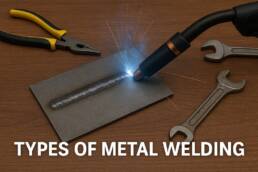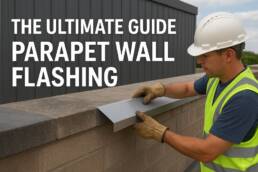Coping is a critical element in building construction. It is often overlooked but essential for both protection and aesthetic appeal. In construction terminology. Coping refers to the protective cap or covering placed on top of walls, parapets, and other structures to prevent water infiltration and damage. This blog offers a practical overview of coping in construction buildings and explores its various types, benefits, and applications.
For over 75 years, C&J Metal Products has been at the forefront of fabricating high-quality architectural sheet metal products. Our expertise in custom fabrication ensures that our clients receive top-notch solutions tailored to their specific needs. Whether you’re a contractor, architect, or homeowner, understanding the role of coping in construction can significantly enhance the durability and visual appeal of your projects.
This guide will look in-depth into the different types of coping, their individual benefits, and their applications in modern and traditional architecture. By the end of this blog, you will have a clear understanding of how coping can protect your structures and improve their overall design.
What is Coping?
Coping refers to the protective cap or covering placed on top of walls, parapets, and other structures to prevent water infiltration and damage. This essential feature acts as a shield against the elements. It’s so that water doesn’t penetrate the wall structure, which can lead to significant damage over time. Coping also adds a finished, polished look to any building, contributing to its overall aesthetic.
Types of Coping
Understanding the different types of coping available is crucial for selecting the right one for your building project. Each type offers its own advantages and are suited to various architectural styles and functional requirements.
Metal Coping:
- Durability and Low Maintenance: Metal coping is renowned for its durability and minimal maintenance needs. Materials like stainless steel, aluminum, and galvanized steel are commonly used.
- Modern Appeal: Ideal for contemporary buildings, metal coping provides a sleek and modern appearance.
Stone Coping:
- Classic Look and Durability: Stone coping are such as limestone or granite. It offers a classic aesthetic and exceptional durability.
- Traditional Architecture: Stone coping is perfect for traditional and historic buildings, complementing heritage architectural styles.
Concrete Coping:
- Versatility and Cost-Effectiveness: Concrete coping is highly versatile and cost-effective. This makes it suitable for various architectural styles and budgets.
- Customization: Can be molded into different shapes and sizes to fit specific design needs.
Benefits of Coping
Coping offers several significant benefits that enhance both the functionality and appearance of buildings.
Weather Protection:
- Water Infiltration Prevention: Coping prevents water from penetrating the wall structure. It reduces the risk of water damage and extending the lifespan of the building.
- All-Weather Defense: Provides a reliable barrier against rain, snow, and other weather conditions.
Aesthetic Enhancement:
- Finished Look: Adds a refined, finished appearance to walls and structures. This feature enhances the overall aesthetic of the building.
- Design Flexibility: Available in various materials and finishes to match different design preferences.
Structural Integrity:
- Additional Stability: Provides extra stability to walls, especially parapet and retaining walls, by reinforcing their structure.
- Damage Prevention: Helps prevent structural damage caused by water infiltration and other environmental factors.
Applications of Coping
Coping is utilized in various applications, each serving a specific purpose to protect and enhance building structures.
Parapet Walls:
- Water Damage Protection: Commonly used on parapet walls to prevent water from seeping into the wall cavity, which can cause significant damage over time.
- Enhanced Durability: Adds strength and durability to the parapet so that it withstands harsh weather conditions.
Retaining Walls:
- Water Seepage Prevention: Used on retaining walls to prevent water from penetrating and weakening the structure.
- Longevity: Extends the lifespan of retaining walls by protecting them from water damage.
Decorative Elements:
- Visual Appeal: Enhances the visual appeal of various architectural features, such as garden walls, terraces, and exterior staircases.
- Design Cohesion: Integrates well with other architectural elements to create a cohesive and attractive design.
Coping is an essential component in construction, offering both protection and aesthetic benefits. Knowing the different types and applications of coping can help in selecting the right solution for your building project. Whether you opt for metal, stone, or concrete coping, each type provides valuable advantages that enhance the durability and appearance of your structures.
At C&J Metal Products, we specialize in custom sheet metal fabrication and offer high-quality metal coping solutions customized to your specific needs. Contact us today to learn how our expertise can enhance your construction projects with durable, aesthetically pleasing coping options. Let us help you achieve the perfect balance of protection and style in your buildings.



